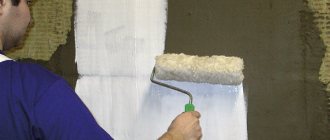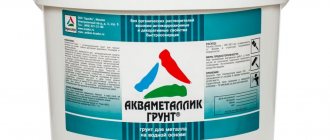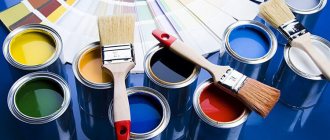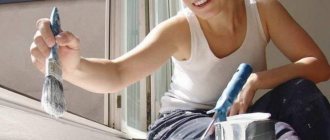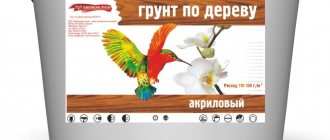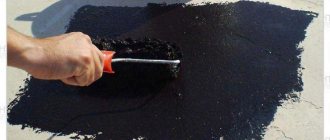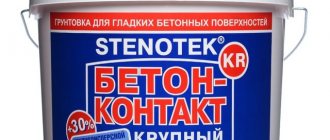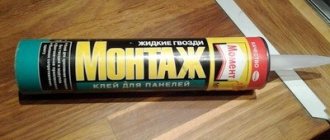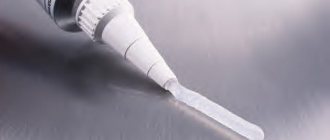Often, during renovations, we hear the following words: the wall needs to be primed before plastering, or before applying tiles. The surface is also primed before putty or wallpaper. What for? And what is this, a primer? What does it look like and what does it consist of...
So, according to tradition, let's start with the definition.
A primer (or construction primer, there is also a universal one) is a special binding composition that is applied to the prepared surface as the first layer, usually before puttying, plastering, painting or wallpapering. The primer can also be applied to the floor before pouring the self-leveling floor. It consists of natural or synthetic components, such as drying oils, various resins (epoxy, formaldehyde, etc.), solid film-forming materials made in the form of solutions and dispersions, pigments are also added (sometimes iron or lead), in construction such pigments can be - talc mica or chalk. When applied to the surface, it forms a film of 0.05 - 0.1 mm.
And now in simple words.
If you want, the primer is a kind of glue or adhesive composition, high penetration. It is applied to prepare the surface for further finishing. For example, all dust is removed and the previous layer gains more strength. The primer penetrates into it and binds, sometimes the penetration of such a composition reaches 1 cm. That is, the previous layer will adhere better, which means the top layer will sit much more firmly. The primer also forms a top layer of uniform composition on the surface.
Why do you need a primer for walls?
Practice shows that the final result of wall finishing depends 80% on the correctly selected primer material. If the mixture is chosen incorrectly, or the surface coating is applied to an unprimed wall, there is a high probability that the applied plaster will soon fall off or crack, the paint will peel off, the wood will begin to rot, and a layer of rust will appear on the metal. So, why do you need primer treatment?
- Improves adhesion . The key function of the primer is to create reliable adhesion between the main surface and the finishing material. Thanks to the primer, the paint or putty lasts for years.
- Strengthens the work surface. Some walls have a weak surface, which means they crack and collapse. The primer penetrates deep into the surface, holds it together and creates reliable support for the exterior finish.
- Antiseptic effect. Primer treatment protects walls, especially wooden or damp concrete ones, from the appearance of fungus and mold.
- Corrosion protection. Applying primer mixtures to a metal wall protects the metal from corrosion.
- Saves finishing materials. Applying paint, varnish or liquid glass to a primed surface allows you to save up to 40% of materials due to the fact that they are not absorbed.
- Moisture protection. The destruction of materials begins with the penetration of moisture, and the primer becomes a reliable protection against its penetration.
- Durability. The finishing material applied to the primed surface lasts for many years without peeling or falling off.
- Easy removal of the layer during the next repair. Having treated the wall with a primer, during subsequent repairs it will be much easier to remove the previous layer.
What is a primer
This is a building composition in the form of a liquid, which is used to treat walls, floors, and ceilings. Performs the following tasks:
- enhances adhesion - the adhesion of dissimilar materials, in this case between
- processed surface and finishing;
- strengthens the foundation;
- levels the layer;
- protects against corrosion;
- saves paint consumption.
The composition of the mixture depends on its intended purpose and the type of surface. It applies to:
- concrete;
- brick;
- tree;
- drywall;
- old paint.
The primer composition must be kept in a well-closed container in a cool, dark room.
General characteristics of primers
A good base should perform at least two functions: firstly, strengthen the application surface, prolonging its durability, and secondly, provide high-quality adhesion to the subsequent material (this could be wallpaper, various types of plasters, etc.).
In addition, it is designed to reduce the consumption of applied material, since it is no longer spent filling the pores; prevent the growth of fungus and mold, the formation of corrosion and absorb the smell of subsequent paintwork, reducing its toxicity.
Being the base layer of absolutely any coating, the primer must meet the highest quality requirements. Therefore, regardless of the type, special attention should be paid to its choice. To achieve the best results and durability, experts advise using primers only for professional use.
You should not skimp on this material also because, by firmly attaching to the surface, a correctly chosen primer can improve the quality of the subsequent coating, eliminating the appearance of craters and air bubbles.
Do you need a primer?
For those who take on the task of independently renovating their home, it is important to remember that without it, high-quality painting is impossible, as is laying tiles, plastering, or gluing wallpaper.
For those who are committed to the idea of renovating a house with their own hands, we offer a short essay-systematization on the use and selection of this product, its place in the process of renovating your apartment. Its difference from paint lies in the smaller amount of pigments and the presence of such a component as a base. A primer is a composition whose application precedes painting in order to enhance the adhesion of the paint to the surface and improve paint absorption.
For better quality work, it is better to choose a product for professional use.
Types of primers
Depending on the area of application and composition, all primers are divided into the following groups:
- alkyd
- acrylic
- polyurethane
- shellac
- aluminum
- polyvinyl acetate
- epoxy
- silicate
Classification of primer compositions is made according to several criteria:
According to the composition of the substance
There are about a dozen varieties.
- Acrylic. The composition of the product allows the surface to “breathe”, despite several layers of soil. Used on various materials, from concrete to wood, in accordance with the manufacturer's markings. There is also a universal acrylic primer.
- Mineral. The base is made up of common materials, such as cement, which makes it suitable for use on different surfaces. Works especially well on porous materials of mineral origin, limestone and plaster. Resistant to moisture and sunlight.
- Alkyd. A material containing polyvinyl chlorides, polyurethane, polystyrene, acetate components and dyes. By their nature, they are actually universal, they can even be used on glass. Enamel, polyurethane and glypthal primers are all its varieties.
- Epoxy. The composition is based, as the name suggests, on resins. In addition to them, the composition contains additives of chemical origin. After treatment, the surface acquires a dense matte or glossy film, which is maximally resistant to aggressive environmental influences.
Distinctive features are resistance to high temperatures and damage. Metal products are mainly processed.
- Silicone. Concentrated binder composition with the ability to provide the most durable coating. An ideal base for silicone-based paints. Working with it requires caution, since the vapors of the substance are toxic. Relevant for work outside residential premises, where enhanced protection from the negative influences of climate and environment is required.
- Silicate. Synthetic base – potassium glass. This primer is used primarily when working with the facade of architectural structures. It can be brick, concrete, or finished with plaster. Maximum effectiveness in tandem with silicate paints.
- Latex. A collective name for a group of materials whose main property is to fill pores and cracks on the surface of walls, ceilings or floors. A significant share in the component composition belongs to the adhesive substance - latex. It is this layer that performs the function of the primary leveling layer and improves the adhesion of the remaining layers to the working surface. Universal compositions are made based on latex.
- Quartz. The basic component in the composition is quartz sand. Additional components – water-dispersed group of materials. Water-repellent properties and a rough surface during processing become the main properties of the primer. It works best as a means to increase adhesion between finishing material and walls.
An additional advantage of soil with sand is its color. In the right shade, close to the finish coat, it provides a beautiful decorative effect. There is harmony between the absorption and reflection of light, and the shade of the paint is revealed as effectively as possible.
- Shellac. It has an unusual composition: milky juice obtained from insects and methyl alcohol. Together they give the effect of a stain under the varnish. Such compositions are actively used in wood processing, as they work like the well-known drying oil, but do not have a strong odor and do not leave oily stains on the wood. They are used to treat the cutting areas of knots on boards, logs and beams to prevent the release of resin.
- Phosphate. Phosphoprimer is a monocomponent material used exclusively for various metals. Mainly in work on the facade of a building, due to the unique abilities of the primer to remove rust and combat its appearance.
- Bituminous. A general name for a number of primers, the main purpose of which is to protect the floor covering. It is used under wooden floors, under various types of flooring, under floor screed (wet, semi-dry, dry and prefabricated).
The composition can vary greatly, depending on the accompanying components. These include: gasoline, rubber waste, mineral mixtures, water, polymers. The primer is highly toxic and requires work in a ventilated area with a respirator.
By degree of penetration
- Surface action. Such compositions form a dense film on wood, concrete, brick, lime, stone, glass and other materials. It fills the porous surface and microcracks, smoothes them before applying putty, and gives a slight roughness, due to which the adhesion of materials improves. All the substance remains on top, without seeping into the deeper layers of materials, which is not optimal in all cases.
- Deep penetration. It differs from surface soils in that it contains substances of a finer fraction that are capable of penetrating into some materials, for example, wood and its derivatives, to a depth of 15 millimeters. Their surface is smoother, and among the components there is always an antibacterial substance. It protects the internal layers from rotting and destruction. Suitable for use on wood, drywall, plaster, concrete, plaster and brick surfaces, cinder block, cement.
By purpose
- On wood. Wood is widely used in construction due to its aesthetic and performance characteristics, but it is difficult to maintain and requires careful selection of materials for processing. The main problem when finishing wood is the high degree of absorption of coloring and adhesive compositions by wood fibers.
In order to save money and for better distribution of the substance, a primer is needed that will prepare the surface completely. It can be an oil, acrylic or mineral based primer. The main requirements are light color, the ability to penetrate deep into the fibers, and the presence of antifungal impurities.
- On plaster. Plaster is susceptible to moisture, soot, and mechanical damage, so the layer must be dense, well-protective, water-repellent and contain antibacterial components. The degree of penetration may vary.
- For metal. The main requirement is protection from moisture and corrosion. One-component compositions, for example, phosphate or shellac, are suitable.
- Concrete contact. It is mainly used for processing floor coverings. Provides protection against moisture penetration deep into the ceiling. Compositions for porous surfaces based on latex, silicone and silicate, universal primers, and bitumen solutions are suitable.
- Universal. It is used if the material is not specific and the microclimate in the room is not damp. The processed material can be plasterboard, wood, plaster, fiberboard, chipboard, plywood sheets and OSB boards.
By place of use
- For exterior decoration. Solutions with high resistance to temperature, ultraviolet radiation, moisture, and mechanical stress. They process the facades of the building. Indoors, such dense coatings will be unnecessary. Because of them, the walls stop “breathing”, and there is a risk of a greenhouse effect.
- For interior work. These are all primers that, according to GOST and specifications, can be used indoors.
By properties
- Water repellent. Forms a protective layer in damp areas. For example, it is used to treat walls before laying tiles in bathrooms.
- Antiseptic. Indispensable when working with wooden bases and when processing old buildings.
- Strengthening. Primer for “clogging” micropores on unstable substrates such as plaster, lime, putty.
- Anti-corrosion. Necessary where there are metal fragments or solid metal surfaces. Prevents rust and rotting of the material.
- Adhesive. Improves adhesion of materials to the base on different planes. It can be used for walls, ceilings and even floors.
- Final. Completes the cycle of rough finishing work and precedes decorative finishing.
- Universal. Used for surfaces that combine several characteristics.
Types and properties
The effectiveness of the treatment is influenced not only by the main purpose of the primer, but also by its composition, as well as the material used to make the wall. The primer can use resins, mineral and acrylic additives, alkyd components, adhesives with the addition of colored pigments, and drying accelerators. Different types of primers may contain minerals or polymers.
In mineral solutions, the binder is cement. Alkyd mixtures are most often chosen for treating wood surfaces, while acrylic mixtures are universal. They are used to coat putty and plasterboard sheets.
Specialized primers for metal
Today there are many primers for metal surfaces. There are the following compositions:
- Alkyd. This primer belongs to the insulating class. It is advisable to use a primer of this type to protect the metal surface from the development of a corrosion process. The composition includes fillers such as zinc white and red lead.
- Passivating. This composition is used to reduce the electrochemical properties of metal surfaces.
- Phosphating. This is a two-component primer mixture that contains orthophosphoric acid and a special filler to reduce its concentration. The peculiarities of using this composition are that it can be used for any type of metal.
- Converters. The solution is used to remove rust. It comes into contact with the rust, making its structure loose, after which it is easily removed.
- Protective. The solution is designed to increase the strength characteristics of the metal. Why is zinc and magnesium used in the composition? After processing, scratches and other mechanical damage do not form on the metal.
- Inhibitory. The mixture does not create a thin film, but can be deeply absorbed into the metal structure at the molecular level, changing the basic properties. Due to this, the surface is more durable and dense.
For interior decoration
Most often, soil is used for preparation before puttying, wallpapering, and painting with dispersion paints. The advantage of these primers is that they perform several functions at once: they penetrate deeply into all layers of the finish, holding them together, preventing the appearance of cracks, and form a film layer that promotes high-quality adhesion of materials.
Moreover, the separation of the primer layer can only be done by force, due to directed mechanical action.
Most often, the primer for finishing work contains a suspension of vinyl acetate or acrylic. There can also be solutions using silicone, this speeds up the drying process and contributes to the appearance of a durable hydrophobic film. These mixtures are best used before wallpapering; thanks to the silicone, later removal of the wallpaper is much easier.
Light primers are characterized by their ability to maintain gas exchange of materials and counteract the appearance of fungus, and also improve adhesion.
Which primer is best suited for each application will determine the finishing method chosen.
For exterior decoration
Exterior finishing, which is done using the “wet” method, involves the use of special primers. The main part of the compositions is based on polymers and various additives. The latter are required to make the treated base resistant to alkalis.
Today, compositions based on artificial resins are very popular. The main scope of application is before installing weld-on or coating waterproofing. Another purpose is the preparation of brick surfaces before painting and the treatment of concrete walls to improve frost resistance.
Universal
It is made on the basis of acrylic copolymers. These primers have good adhesive properties and excellent contact with paint coatings. This type is also used for processing foam concrete, concrete, gypsum, wood and stone walls. Universal compounds are also used for treating surfaces before gluing wallpaper or puttying. Externally, the primer looks like a transparent liquid.
Important: If you need to emphasize a specific property (for example, high corrosion resistance, increased light reflection), it is best to buy a mixture specially designed for this.
The need for priming and its advantages
The surface prepared for gluing, upon closer examination, shows irregularities and roughness invisible to the eye, which can affect the quality of adhesion to the decorative coating or disrupt the smooth surface of the wallpaper. The mechanism of action of the primer differs depending on its type.
Strengthening primer glues surface microparticles together, forming a smooth, dust-free surface on which glue and paint can be easily applied. Such primers are white due to the content of large particles of the binder component, which cannot be deeply absorbed.
Deeply penetrating soils fill the micropores of the base thanks to the smallest particles penetrating to a sufficient depth, further strengthening the working surface. The color of such primers is a cloudy liquid.
All treated surfaces are subject to mandatory priming - floors, walls, ceilings, metal structures before plastering and puttying, painting and laying tiles and other work.+
There are several answers to the question why a primer is needed, thanks to it:
- The surface becomes uniform and smooth.
- The working surface is additionally strengthened.
- Glue or paint is applied ideally, less material is absorbed into the surface.
- Spots are masked.
- Glossy finishes are more shiny.
- The smell of paint is neutralized.
- It is possible to use light paint on a dark surface.
- Transformation of rust from a destructive into a protective layer.
- Prevents the appearance and development of mold and rot.
Popular primers
The primer mixture is divided into 3 types:
- dye;
- deep penetration agent;
- concrete contact.
The paint is used on a smooth and even base. For porous, rough and moisture-absorbing areas, deep penetration coatings are used. Concrete contact is applied under decorative plaster.
Acrylic primer impregnation is suitable for concrete, brick, drywall and stone. For wooden and metal bases - alkyd. Brick and external plaster are treated with silicate.
Top sellers are Ceresit CT 17, Tiefgrund LF D 14, Bindo Base, Acton, Opti Grund ELF
Choosing the right primer
Primer is a mixture of pigments, fillers and binders. To bind together the micro-relief of the surface, strengthen it and cover it with a continuous waterproof film - that’s what a primer is for. The choice of material, which takes place according to several parameters, also depends on the nature of the working surface - wood, metal, plaster.
Depending on the type and condition of the surfaces. A working surface in good condition that does not require additional reinforcement can be treated with a strengthening primer, which removes dust and, “working” only with the top layer of the surface, covers it with a film.
Deep penetration primers are absorbed by the working surface to a depth of almost 10 cm due to the smallest particles of the binding component (unlike the strengthening primer). This primer option is quite expensive and should not be used unless necessary.+
The finishing material involves the use of a primer with a similar base. For example, water-dispersed paint requires the application of an acrylic water-soluble primer, while an oil-based primer requires the application of an oil-based paint.
It should be remembered that each surface has its own primer:
- For any surface except metal, acrylic is suitable - often used at home. It dilutes well with water and is easy to work with. Penetrates deep into the surface up to 1 cm.
- Alkyd is suitable for wooden surfaces, as well as under fiberglass, tiles, tiles, and PVC.
- Special primers for various metal surfaces.
Soil drying time
The time it takes to carry out repairs or finishing work during construction directly depends on how long the primer dries. The period during which the applied composition dries depends on the conditions in the room. There is a direct dependence on the ambient temperature and humidity.
On average, at +20 degrees and normal humidity, drying time, depending on the type of primer, is 3 – 5 hours. However, to obtain 100% results from the priming process, it is necessary to wait 24 hours between coats. Applying the topcoat must also begin after 24 hours of exposure.
Curing of walls after priming Source blockopsgroup.co.uk
Colors
The color of the primer is of fundamental importance. A correctly selected shade that matches the shade of the decorative coating solves several problems at once.
- Checking the uniformity of the primer layer. The more contrasting the color of the rough surface and the primer, the more obvious any shortcomings are. This is very convenient for eliminating all defects at the preparation stage.
- Improving the quality of the finishing coating. There is no doubt that a white base for white wallpaper (especially thin ones) is more suitable than a brown one. Likewise, the gray primer allows the gray paint to show its full potential.
- Saving on the amount of finishing materials. When it comes to renovations in a residential area, where it is difficult to find a room smaller than 8 square meters, the number of required layers of paint for decorating the walls can both significantly reduce and significantly increase the cost of repairs.
- Save time. Minus an extra layer of paint – minus an extra half day of physical work with a roller and a stepladder against the wall.
- Extending the service life of the coating. At first glance, this is an insignificant detail, but in practice it is perhaps the most important. If the color of the primer is chosen to match the paint on the walls, then instead of mechanical damage (impacts, chips, scratches), where the decorative layer is primarily damaged, the damage will remain invisible. When using different shades, the appearance of the finish will quickly become unusable. Whatever one may say, the difference will be noticeable even between two light shades.
- Provides a presentable appearance as a final coating. For example, when in some interiors it is important for the style to preserve the texture of wood, stone or limestone. A varnish primer is used for wood and a matte primer for other surfaces.
Various manufacturers offer rich color palettes to choose from. Among light primers, white, biscuit, milk, beige, lavender, cement gray, silver gray, pistachio color, spring shades of yellow, green and pink are popular.
Among the more saturated paints, you can choose brown primer, blue, green, terracotta, vanilla, Prussian blue, Marsala, purple. The darkest ones include graphite and black.
Separately, it is worth highlighting the primers for the topcoat, which are dominated by natural shades: pear, chestnut, mahogany, teak, oak, walnut, rosewood, birch.
Alkyd primer
The base component is an alkyd resin supplemented with zinc chromate or phosphate. Primer with zinc phosphate is mainly intended for metal surfaces, that is, anti-corrosion.
But the composition with zinc chromate can easily be classified as universal, which allows it to be used for impregnation of any type of base.
Compound:
- alkyd resin (alkyd varnish);
- zinc phosphate/zinc chromate
- driers;
- solvents;
- stabilizers.
Alkyd primer is an ideal solution for use on wood, tile and glass surfaces. But: it interacts poorly with plasterboard and mineral (plastered) walls. Drying time can reach 15 hours.
Application Tips
Before applying the primer, you need to prepare and acquire all the tools and materials. In addition, it is important to comply with all safety requirements. First of all, it is recommended to protect your eyes with special construction glasses, and your hands with gloves.
You should make sure that there are no allergic reactions to the components of the primer and all its components. Otherwise, it is better to refuse to do the finishing yourself and seek the help of specialists. When applying primer, you should try to avoid getting it on the body. This rule is due to the fact that it will subsequently be quite difficult to wash it off yourself without using specialized products.
In order to thoroughly prime the walls, you need to acquire the following tools:
- brush;
- roller on a long handle;
- fine-grain sandpaper or sanding machine;
- spatula;
- scraper;
- putty;
- primer tray;
- chemical remover;
- protective elements (goggles, gloves).
Of course, it is also necessary to purchase a primer suitable for finishing work.
Even an inexperienced builder who is encountering this for the first time can handle priming walls. Before proceeding with this process, you need to thoroughly clean the surfaces of dirt, dust and construction debris. If there are cracks on the surface, they need to be cleaned with sandpaper and puttied. Under no circumstances should so-called breathing areas be left on the walls.
If the primer is applied to wooden surfaces, then you need to get rid of all roughness and irregularities. All rusty areas are cut off from metal surfaces.
Before priming, first of all, it is necessary to sand the working surfaces. To do this, it is better to use a grinding machine or sandpaper. But initially, the surfaces are cleaned of old finishing materials, such as paint, wallpaper, and a layer of rust. Pellets, if any, are removed from surfaces. To do this, you can use a wash or a spatula, as well as a scraper.
If there are irregularities on the walls no more than 2 cm thick, then it is necessary to use putty or a primer with a thick texture to level them. Thus, coatings in the form of a primer can only be applied after a week, when the previous finishing layer has completely dried.
You can also switch to using a primer when the old coatings are completely sanded.
The finished primer composition must be poured into a special jar to the desired level. Do not fill the container full, otherwise there will be a chance of spilling it. Before priming, it is recommended to shake the mixture thoroughly, even if it seems homogeneous. In this container, moisten the brush or roller evenly so that the soft elements of the tools are well saturated.
It is important to distribute the primer evenly over the entire surface - do not leave gaps. The roller must be slowly and carefully rolled over the entire surface to completely saturate it with the primer. It will be noticeable how it is saturated with soil. That is why the priming process must be thorough and careful. This procedure will take quite a long time.
Work usually starts from the window of the room. It is better to divide the room into sections of about one and a half square meters and apply the mixture in stages.
To apply the primer, you can use a spray gun - it allows you to paint the walls most evenly and leave no gaps. But not everyone can handle such a tool. In addition, if you decide to use a spray gun, it is recommended to wear a respirator on your face, since the composition will saturate the air.
Particular attention should be paid to wall joints, as well as surfaces near radiators and other difficult areas. The primer is usually applied in several layers. Their exact number depends on the looseness of the base. If it does not consist of foam concrete, then it must be covered with soil at least three times - only after that a reliable film is formed on it, which improves adhesion.
Each applied layer must be completely dry before applying the next one. It is enough to dry the first layer for an hour until the wall absorbs moisture. Then you can proceed to applying the next layer. But if moisture absorption at the surface is poor, then you need to wait a little longer.
The final drying time for the primer depends on the temperature in the room. If the room is colder and the air humidity is higher, the primer will take much longer to dry than under normal conditions. If the air temperature is below 10 degrees, then it will take about four days for the primer to dry. But if the room temperature is about 20-25 degrees, then the primer layer will dry out in less than a day. After the primer has dried, it is important to quickly move on to applying decorative coatings.
If you need to prime the walls before applying plaster, it is better to use concrete contact primer - it protects surfaces from dampness and moisture and better saturates concrete walls. For finely porous surfaces, it is better to use a polyurethane or epoxy primer mixture. They are capable of leveling and strengthening almost any standard base base.
Primer application
How to choose the right primer
The choice depends on the material on which it will be used. If the condition is good, we take a strengthening base that will remove dust and cover it with a protective film.
If the plane needs deep bonding, a deep penetration product with fine particles is required.
We also take into account the features of the finishing used. A water-soluble primer is used for water-dispersed paints, and an oil-based primer is used for oil paints.
Acrylic is used everywhere except metal. Various specialized primers are used for it.
Passivating neutralizes the effect of water.
Protective - neutralizes the effect of the electrolyte.
For rusty surfaces, you can use a rust converter.
Primer Tool:
- Brushes, rollers
- Spray
- Fine emery, grinding machine
- Scraper, spatula
- putty
- Wash
- Bath for composition
- Protective equipment: glasses, gloves
Consumption is based on approximately 150 ml per 1 square meter of surface.
Rules for applying primer:
- Cleaning the base of all foreign elements by mechanical action or washing. Unevenness up to 1.5 should be leveled with putty and dried for up to 1 week.
- If desired, sand with a sander or sandpaper.
- Ground application.
- pour it into a bowl, dip a brush or roller into it
- apply it to the base, corners and behind the radiators
- Wait until the layer dries completely. Low temperature and high humidity are unfavorable. The optimal temperature is about 20 degrees C.
- After the second layer has dried, you must immediately apply paint
- loose base, such as foam concrete, needs more product.
Safety precautions when applying primer:
- Protect your eyes and hands with goggles and gloves
- Be aware of the possibility of an allergic reaction
- Avoid getting it on your body, because... it doesn't wash off well.
Interaction with different surfaces:
- Concrete. It is best to use a penetrating one, especially before applying a self-leveling floor mixture.
- Wood, plaster. Water protection.
- Smooth surfaces. Finishing materials easily fall off the smooth surface. A special primer with quartz sand is required to hold the finish.
- Protection against bacteria and mold. Required with antifungal and antibacterial additives. If mold appears in at least one area, all walls must be treated for protection.
Features of working with various types of primers
- Quartz. It is applied to plasterboard walls, a layer of putty is applied on top of the first layer, then a second layer is placed on the putty, and then paint and varnish is applied. Its color should match the color of the paint.
- Concrete contact. For dense non-absorbent products such as blocks, walls, ceilings, monolith. Before plastering, they must be treated with concrete contact.
- It cannot be replaced by polymer dispersions or water-based paints; when using them, a defective result is inevitable.
Manufacturers of the best primers:
- Tikkurila, Finland
- Sherwin-Williams, USA
- Finncolor, Russia
- Beckers, Sweden
- Henkel Bautechnik (Ceresit ST 17)
- Dali primer-enamel for rust
- Olympic (Acryl Grundierung)
- Belarus (Belinka)
It is better to take primers and dry mixtures from the same manufacturer; they combine better.
Primer packaging
Ready-made mixtures, undiluted concentrates and dry mixtures, sometimes cylinders.
This is the most necessary knowledge about it for people who love repairs. Good luck to you, work without culling, and the right selection of combinations of finishing products!
Storage conditions
The primer must be stored in a tightly closed container. Moreover, it is necessary to place it in a dark and not too humid room, excluding direct sunlight on the container with the composition. Good ventilation must be provided to extend the shelf life of this material. Its location near sources of open fire, as well as heating devices, is not allowed. It is better to exclude the presence of operating electrical equipment nearby.
It is important to pay attention to the expiration date of such a composition. If the primer suddenly expires, it must be replaced with a new one. Otherwise, this may lead to delamination of the material and a decrease in its properties. The primer is best stored at standard room temperature. If you place it in an unheated room, large lumps will appear in it and the composition will not be so uniform, which will affect the quality of the finish of many surfaces.
A non-sealed composition will be susceptible to the formation of a thick film on the surface and deterioration, so it is important to tightly seal the composition when using the mixture once.
Most manufacturers indicate a shelf life of 12 months. But subject to the necessary rules and storage conditions, the period can be extended by about another six months.
If the soil has not been used for a long time, it may stagnate and become a little thicker. To avoid difficulties during application, it is recommended to bring it to the desired consistency using solvents.
Polyvinyl acetate primer
Application is recommended only on surfaces subsequently painted with paints containing PVA components. The soil is very easy to work with. At the same time, the drying speed of the base is in no way inferior to its acrylic counterparts, and even, on the contrary, exceeds it (30 minutes).
However, the soil also has several significant disadvantages, which makes it not very popular.
Compound:
- polyvinyl acetate dispersion/latex;
- stabilizers;
- pigmenting substances.
The resulting PVA film is practically airtight, which makes it difficult for microcirculation of air in the room. This can cause condensation and mold to form. It is extremely irrational to use on wet surfaces. Also, the adhesive primer peels off quickly.
Alkyd primer
This is a primer based on alkyd resin. Area of application: primary treatment or application to previously painted surfaces made of wood, particle boards, and wood fiber. It also has excellent adhesion to PVC, glass, galvanized steel, fiberglass, and tiles. White spirit is used as a thinner and cleaner.
Any type of paint fits perfectly on it: latex, alkyd, enamels, acrylic, nitro dyes, all types of putties, PVA glue, universal and wallpaper glue.
The composition of the alkyd primer allows you to work with it even at low temperatures; its toxicity is relatively low, which does not require special protective measures, except for constant ventilation of the room during work. Among the advantages of this soil are its availability and low price.
In turn, the material comes in three types:
- A special moisture-proofing primer has anti-mold and antifungal properties
- Pigmented primer creates a semi-matte, durable film and enhances the depth of the next color
- Zinc in the mixture gives it anti-corrosion properties.
Primer consumption
Primer consumption per 1 m2 for plaster is 100-160 g. Primer consumption per 1 m2 for putty is 50-120 g. On particularly porous and friable surfaces, consumption can increase to 200 g or more per 1 m2. As for concrete contact and similar soils, the consumption for smooth concrete is 1 liter per 4 m2.
The concentrated composition is enough for a much larger area.
The only tools you will need are:
- Brush
- Roller
- Tray or container for primer
- Snatch film
- Masking tape
- Vacuum cleaner
- Putty knife
The primer can be used at temperatures from 5 to 30 degrees Celsius
Disadvantages of alkyd primer:
- Its actual drying time is up to 16 hours, despite the manufacturers’ words that 4 hours at a temperature of 12°C is enough. If the soil is not dry enough, some paints may curl upon contact with it.
- When using white spirit solvent, the toxicity of the material increases: the room must be ventilated until the soil is completely dry.
- This type of mixture is not used to strengthen a loose and crumbling surface, since it does not penetrate deep into its layer.
- The roller or brush cannot be cleaned after use. There is only one way to store them - they are wrapped in rags soaked in white spirit, and a plastic bag is put on top and tied tightly. In this form, the instrument is stored for no more than two days, after which it dries out.
- If the construction synthetic mesh does not fit tightly to the surface, then when soil gets on it, it will be stretched and deformed.
How to choose a primer
If the surface is very loose and very dusty, then you definitely need to use a deep impregnation primer. I recommend quality material such as Caparol or KNAUF. Not bad soils are produced by Ceresit and Condor. There is a caveat: if something falls off after finishing, the company that sold you the material emphasizes that you did not use their primer and did not use the technology, so be careful. The best primer in my personal experience is the sealer; the price is off the charts, but the quality and results are excellent.
I recommend only Caparol Putzgrund 610 as an adhesive primer. It is more expensive than its analogues, but is of better quality than its analogues and the consumption is much lower. This is my personal conclusion from experience working with similar materials.
Priming of mineral surfaces
Mineral surfaces include brick, cinder block, concrete, aerated concrete, plaster, and so on. That is, the materials that mainly make up the walls and ceilings of buildings.
The leading position in the preparation of “bare walls” for subsequent coatings is occupied by a deep penetration primer. The mechanism of action of which is the deepest possible impregnation of the base material, while the polymer component is well bonded to the base particles, leaving the treated surface porous. This significantly increases the adhesion of the next layer to the mineral base. Often deep penetration primers have fungicidal (antifungal) additives.
If the surface is too loose, porous, or not durable, then a strengthening primer will be required. This mixture contains more adhesives, that is, when they penetrate the material, they noticeably strengthen its top layer. Note that primer consumption depends on the porosity of the surface being treated. Strengthening primers are often used when working on plaster containing insufficient amounts of cement in old buildings. But we should not forget that such mixtures strengthen the material only to the depth of their penetration - they will not save crumbling plaster.
Universal, or general purpose primer, is applied between coats. It improves adhesion, allows you to apply paint evenly, etc. When choosing it, you should take into account not only the base material, but also the layer applied next.
An anti-alkali primer is only required when using solvent-based paints to treat alkali-containing surfaces. These may include new concrete, cement screed or a surface treated with fire retardant agents.
Betonokontakt primer is used to treat smooth hard surfaces, such as concrete slabs, drywall or oil-painted substrates. This mixture contains sand and cementitious additives, which makes the surface rougher. Thus, a smooth surface with poor adhesion becomes suitable for subsequent plastering, puttying, gluing tiles and other finishing works.
Priming walls depending on the surface
Concrete walls
For concrete bases, deep penetration acrylic primer is used. This composition allows you to increase adhesion and also eliminate minor surface roughness (scratches, chips).
Brick structures
Before priming a brick wall, you need to pay attention to the condition of the surface. If there is damage and the mortar spills out in the seams, then it is necessary to use a water-dispersed primer, which will strengthen the plane of the wall and give it adhesive properties.
You can also use mineral compounds based on cement, gypsum or lime for strengthening.
Walls made of facing bricks require treatment with water-repellent agents, which will prevent the appearance of efflorescence (white deposits) on the masonry.
Primers for metal
When treating metal surfaces (ferrous metals) with noticeable traces of corrosion, a rust converter is used first. After its use, mechanical processing is carried out. And only then can the surface be primed, even if the primer contains orthophosphoric acid (the main component of the converter).
Anti-corrosion primers for painting are used differently for ferrous and non-ferrous metals (galvanized iron is primed with compounds for non-ferrous metals).
What primers can I use?
For preparatory work, you need to select the best material, which is a primer. Manufacturers today offer acrylic, alkyd, mineral and quartz mixtures. Each of them must be used for specific jobs and materials. Thus, acrylic primer mixtures are used for preliminary preparation before painting work in which water-based paint will be used. Such a primer before painting the walls will ensure that the paint adheres more tightly to the wall surface. But alkyd primer should not be used for treating plasterboard walls, as well as plastered surfaces.
The primer can be transparent
The best primer manufacturers
In order not to get lost in the selection when visiting a construction supermarket, we will give a description of the most attractive primer mixtures according to observers.
— Tikkurila Otex. A universal primer that is a recognized leader in the processing of metal coatings. In addition, this material is the best in terms of price and quality ratio. What also captivates buyers is its quick drying. True, the consumption of such a primer is 0.7 liters per sq.m. leaves much to be desired.
— Ceresit 17. One of the best primers for deep penetration and working with concrete. It is characterized by high frost resistance, and therefore behaves well during outdoor work. True, users note an unpleasant odor and a rather high cost, but experts call Ceresit 17 the best primer for wallpaper.
— Eskaro Aquastop Professional. A true leader among primer mixtures for exterior use. This is a moisture-proofing material that provides reliable waterproofing of literally any surface being treated. The advantages include a high drying speed. The only thing that stops buyers is the too high price.
— Belinka Base. The best primer for wooden coverings made in Slovenia. The material based on alkyd resins penetrates deeply into the wood and perfectly protects it from the growth of fungus and rot. These advantages do not prevent such a primer from having a low price, which is why buyers love it so much. It is only important to remember that Belinka Base emits a strong odor when working and takes at least 24 hours to dry.
Silicone primer
Another type of water-dispersion composition, endowed with universal performance characteristics.
Compound:
- silicone suspension;
- acrylic polymer dispersion;
- additives that accelerate the polymerization of the solution;
- plasticizing additives;
- preservatives.
Such primers are distinguished by excellent vapor permeability and layer adhesion. At the same time, the composition optimally strengthens the surface and extends its service life. Typically, silicone primer is used for facade work with porous substrates. However, there are soils for interior work.
How to apply primer
- Prepare the work surface by removing dust and dirt. Wash off the whitewash from the wallpaper with water, wet the wallpaper with water and remove with a spatula.
- Pay attention to the air temperature, which should be within +5...+30°C.
- Prepare a brush, roller and tray for the primer mixture. If necessary, have a stepladder.
- Dilute the primer according to the instructions (if necessary), or simply mix it well (if it was sold ready-made).
- Pour the working mixture into the tray, soak the roller in it and start rolling it over the wall, spreading the primer in an even layer. Make sure that it does not splash or flow down the wall.
- Carefully coat the wall with primer, leaving no dry areas. For hard-to-reach places it is better to use a brush.
- Once the entire wall has been treated, allow the primer to dry for at least 3 hours (the exact time is indicated in the instructions), and apply a second coat. For high-quality surface preparation, it is necessary to apply at least 2 layers of primer.
- When the second layer is completely dry, you can begin applying paint, wallpapering and other finishing touches.
Primer is an important finishing material that should not be neglected. With the proper approach, it will ensure the durability of your renovation, and even years later it will delight you with a nice finish!
Phenolic primer
It is classified as anti-corrosion. Designed for processing wood and metal surfaces, in particular titanium, copper and ferrous metal bases. In addition to its anti-corrosion properties, phenolic primer can increase the service life of the treated base and its subsequent finishing.
Compound:
- varnish based on synthetic phenol-formaldehyde resins;
- vegetable oils;
- solvent.
As you can see, the soil is not environmentally friendly, so it is better to avoid using it for treating indoor surfaces.
The surface is ready for finishing after 12 hours.
Let's solve the riddle: what comes first - primer or putty on the walls?
The correct sequence of finishing work is a 50% guarantee of success, so anyone planning a renovation needs to know how to prepare a wall for finishing. The only correct answer is primer. Coatings on any base material, be it wood, metal, drywall or concrete, must adhere well, so we use a primer first.
Anyone who has ever wondered what comes first, putty or primer, should remember that the putty should be applied after the primer, in the second stage. After all, even 10 layers of primer will still copy the contours of the surface. In order to make it smooth and prepare the wall for subsequent finishing work, we apply putty. To make the effect as close to ideal as possible, the dry putty on the wall will need to be sanded.
photo from the site https://nashaotdelka.ru
Is a primer necessary before puttying?
Of course, you could putty the wall without first applying a primer to it, but in this case, the quality of the work done, even when using the most expensive putty material, will be significantly reduced. You should expect that the wallpaper may soon peel off, the plaster will fall off, and the surface will become covered with cracks and stains.
If you are wondering whether a primer is needed before plastering, then for those who do not want to return to repairs in the coming years, the answer will be unequivocal - it is necessary. It is necessary to prime, first of all, so as not to be afraid that the plaster may crumble. For plaster, the soil base will become a rejuvenating apple, which will prolong its life and maintain an attractive appearance for a long period of time.
Phosphate primer
It is also phosphating. Designed to improve the adhesion of the metal base to the paint layer, while preventing rusting of the metal.
Compound:
- organic solvents for synthetic resins;
- pigmenting corrosion-resistant pigments;
- corrosion converters.
The peculiarity of application is the need for processing in 2-3 layers.
Phosphate primer requires preparing a mixture for impregnation not with water, but with an acidic solvent.
Latex primer
It belongs to the water-soluble group, which makes it safe. After drying, it forms a matte, vapor-permeable film. Usually available as a one-component mixture.
Compound:
- styrene acrylic latex;
- defoaming agents;
- antiseptics;
- fillers;
- modifying additives;
- preservatives.
The primer has found its application for the treatment of internal surfaces, in particular the treatment of loose, old, crumbling and porous bases of concrete, brick, plaster, plasterboard and putty. Most often used for plasters, putties, tile or wallpaper adhesive, as well as paint.
